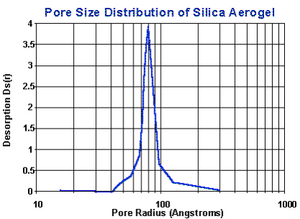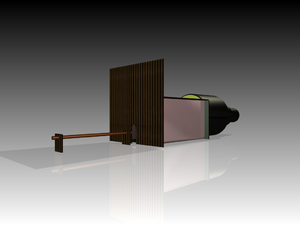MainPage:Nuclear:Summer2014:AerogelAbsorptionLength
Abstract
The purpose of this experiment is to determine the scattering and absorption lengths of aerogel produced by Matsushita Electric Works for use in Cherenkov detectors at Jefferson Lab. These tiles detect particles because when a particle passes through a medium faster than light travels in that medium it emits light and slows down. Cherenkov detectors detect particles via the presence of this Cherenkov radiation, and the cone of radiation emitted as the particle moves can be used to determine the momentum and hence mass of the particle, identifying the particles. Because light traveling through aerogel is fundamental to their use as Cherenkov counters, knowledge of the optical properties of aerogel is essential. The two major optical properties measured are absorption and scattering: measures of the likelihood of a photon being absorbed or scattered as it passes through a material. These properties will be tested at a variety of refractive indices of aerogel. Both properties will be tested by shining a collimated beam of light through aerogel tiles, and measuring the resulting change in intensity with a photomultiplier tube. A blue LED will be used to test these properties. In visible and longer wavelengths, scattering in aerogel occurs at shorter distances, and absorption at longer distances. While both processes are always occurring, scattering will has a great effect over large distances, and absorption has a very small effect over shorter distances. Thus scattering will be measured first, at short aerogel thicknesses of 1-5 cm, where absorption will not have much effect. Absorption will be measured at longer distances of 10-20 cm, and the previously calculated scattering will be taken into account. With this the optical properties of various Matsushita aerogels will be known.
Aerogel Structure
Silica Aerogels are produced by replacing the liquid portions of a gel with gas, usually with supercritical drying, resulting in a structure comprised of chains of silica molecules and microscopic gas pockets. The Aerogel used was produced by Matsushita Electric Works, through a process which waterproofs silica particles in the gel, resulting in a significantly longer lifetime for the tiles produced. This is because while areogel is typically hydrophilic, taking in moisture from the air and reducing in optical quality, the Matsushita aerogels are hyrdophobic, causing their quality to be maintained for longer periods of time. Aerogels in general tend to have a refractive index around 1.01 to 1.06, and the tiles tested will have refractive indices of approximately 1.01 and 1.03. Aerogel contains pores distributed without it, the number and size of which vary based on how the aerogel was produced. Aerogel pores tend to have sizes ranging between around 2 nanometers to 30 nm. While the silicon particles in aerogel are extremely small, the larger pores scatter light. The light tested had a wavelengths in the hundred nanometer order of magnitude, which makes the pore size approximately one order of magnitude less than the wavelength of the light. This leads to Rayleigh scattering occuring in aerogel, which is responsible for its bluish color.
Scattering and Absorption Length
Rayleigh scattering occurs when particles much smaller than the wavelength of light interfere with electromagnetic radiation. Because of this, the scattering of light in aerogel is highly dependent on the wavelength of the light passing through the aerogel. In the visable range, the absorption length of light in aerogel remains for the most part constant. Scattering and Absorption Length are the length into a material at which the probability that a particle passing through the material has not been absorbed drops to 1/e, and it characterizes the negative exponential trend of that probability: The Probability that that a photon has not been scattered or absorbed is P=ex/Λ, where Λ is the scattering or absorption length and x is the distance into the material which the photon has passed.
Materials and Methods
- 5 11x11x1cm Matsushita Electric SP-30 Aerogel tiles
- Case for holding Aerogel
- Photomjltiplier Tube
- 470 peak wavelength LEDs
- Collimator tube
- PMT Apeture
- Darkbox
The LED light is collimated by a long tube painted black on the inside. This restricts the angles at which the LED light can leave the tube, focusing it into a beam though greatly reducing its intensity. The led is elevated to a height so that it is aiming through the center of the aerogel tiles. The aerogel tiles are held in a black case, which should minimize any light scattering back to where it would be collected. An Aperture with the same diameter as the collimator is placed over the PMT, aligned with the it so the PMT will not capture any scattered light. The intensity of the light with and without the aerogel will be used to calculate the scattering length. After scattering length is measured. Absorption length was measured by Indra using a different setup designed to reflect scattered light back to the PMT to measure only absorption. In measuring scattering, different combinations of aerogel tiles were used in order for the experimental data to give a more accurate picture of the optical qualities of the aerogel population as a whole.
Presentation
Report
Data
Citations
Aschenauer, E.; Bianchi, N.; Capitani, G. P.; Carter, P.; Casalino, C.; Cisbani, E.; Coluzza, C.; De Leo, R.; De Sanctis, E.; De Schepper, D.; Djordjadze, V.; Filippone, B.; Frullani, S.; Garibal-di, F; Hansen, J. O.; Hommez, B.; Iodice, M.; Jackson, H. E.; Kaiser, R.; Kanesaka, J.; Lagamba, L.; Muccifora, V.; Nappi, E.; Nowak, W. D.; O’Neill, T. G;; Potterveld, D.; Ryckbosch, D.; Sakemi, Y.; Sato, F.; Schwind, A.; Suetsugu, K.; Shibata, T. A;. Thomas, E.; Tytgat, M.; Urciuoli, G. M.; Van de Kerckhove, K.; Van de Vyver, R.; Yoneyama, S.; Zhang, L. F. Nucl. Instrum. Methods Phys. Res., Sect. A, 2000, 440, 338
Whippe, C. Matsushita Improves Silica Aerogel. Photonics Spectra.
Mukherjee, S. P., J. F. Cordaro, and J. C. Debsikdar 1988 Pore structures and microstructures of silica gel monoliths at different stages of sintering. Advanced Ceramic Materials 3: 463-467.
Raphi Dror, Galit Bar, and Mariana Pokrass, Density distribution of highly porous silica aerogels using refractive index measurements
Makoto Tabata, Ichiro Adachic, Yoshikazu Ishiia, Hideyuki Kawaia, Takayuki Sumiyoshid, Hiroshi Yokogawae Development of transparent silica aerogel over a wide range of densities
A.R. Buzykaev, A.F. Danilyuk, S.F. Ganzhur, E.A. Kravchenko!, A.P. Onuchin; Measurement of optical parameters of aerogel, Nuclear Instruments and Methods in Physics Research A 433 (1999) 396}400





